home vintage cameras index



A 1955 ad for the Contaflex. Note the $169 price at the bottom of the ad.
Adjusting for inflation, that works out to be about $1,344 in today's dollars.
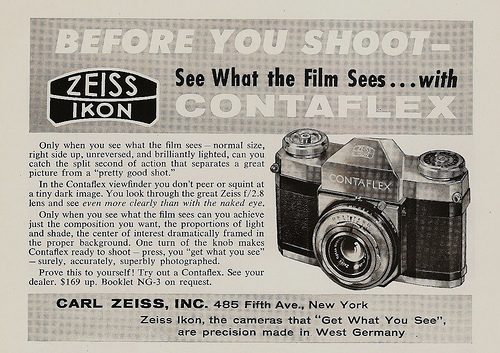
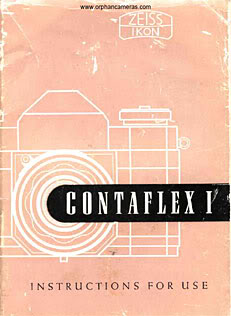
The user manual for the Contaflex is at the Butkus site.
This first model of the Contaflex was introduced in 1953.
Zeiss adapted exisiting post-war design ideas as well as earlier ones to produce this uniquely compact 35mm single lens reflex camera. The fixed lens on mine is an f2.8, 45mm coated Tessar. Since the slr mirror is not instant-returning, the film advance knob must be wound to cock the between-the-lens leaf shutter and bring the mirror down into viewing position. Having the view black out after pressing the shutter release takes a little getting used to for photographers accustomed to more modern cameras. Balancing out that slight inconvenience is the fact that this is still about the only full-frame 35mm slr that can easily be slipped into a jacket pocket. The camera is really only marginally larger than the tiny Ikonta 35, and according to Mike Elek, the lens design of the Tessar is identical in the two. Over-all, materials and construction are top drawer, and the camera is a pleasure to hold and operate.
My camera, purchased for not very much on ebay, came with the impressive Teleskop 1.7x accessory lens, which yields a focal length of about 75mm, a nice portrait length. I was looking forward to using the telephoto accessory, but could not at first see how that was going to be possible as it clearly does not screw into the front of the fixed lens Tessar. A little research revealed that I was lacking the necessary mounting bracket. I wrote to the seller, he rummaged around in his tool box, turned up the bracket, and sent it to me at no additional charge - a stand-up guy. To mount the accessory telephoto, you first install the slip-on bracket, and then screw in the Teleskop. The fixed Tessar needs to be set at the infinity mark to enable proper focusing with the telephoto. The bracket is also used to mount a stereo photo accessory.
As luck would have it, I already had several filter adapters and a lens shade which I could use with the camera. All of these are Series V, 28.5mm push-on models. The set of four accessory close-up lenses was purchased separately for about twelve dollars. I like the push-on type lenses for close work as they require no exposure compensation as do extention tubes on other slr cameras.
The plastic-cased close-up set is a good example of Zeiss design thoroughness. The back of the case features a pretty depth-of-field calculator. Inside the case, each lens is securely held in place by raised tabs so as to minimize fumbling in the field. If you closely examine the mounting tabs on the accessory lenses, you see that there are three pairs on each lens, with one half of each pair bent slightly inward to grasp the tabs in the case, and the other of the pair is adjusted slightly outward to provide a secure fit against the inner surface of the lens focus ring.
The camera shown here is my second Contaflex; the first was a non-working one received as a gift. I managed to get that original one working well enough to put a couple rolls of film through it and to develop some respect for the quality performance that the camera was capable of delivering. In that same process, I also learned some important lessons about acquiring and owning a Contaflex all these many years after it was produced by Zeiss.
The most important of these lessons, perhaps, was that claims about the working condition of an old Contaflex are meaningless unless they are accompained by a recently taken roll of film showing proper exposure. Old Contaflexes often sound like they are working perfectly, but the chances are slim that the complex train of events leading to an exposure in a Contaflex is going to happen in just the right way to put an image properly on film.
The biggest and most common problem with the Contaflex is a slow aperture stop-down mechanism. One also sees mirrors that don't don't quite close quickly enough, sticky shutters, and dirty internal lens surfaces. Since I like the camera so much, I sent it off to have the slightly sticky aperture repaired along with a few other minor things. It worked ok for a while after that, but the aperture started acting up again. I finally summoned the courage to tackle the problem myself. I separated the shutter and lens from the body and found that the aperture blades and actuating mechanism were dirty. Near the extremes of open and closed, the blades moved very stiffly. I cleaned everything with lighter fluid and Radio Shack electronic cleaner, and then dried thoroughly before reassembly. The task was made immensely easier by access to a discussion of the problem and how to fix it at the Classic Cameras Repair Forum, along with some helpful sketches by Rick Oleson.
The color photos were made in Albuquerque just before Halloween, 2008. This was after fixing the sticky aperture.
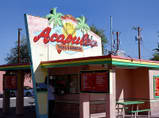
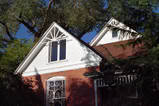
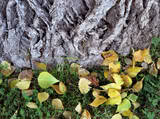
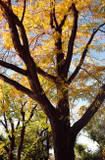
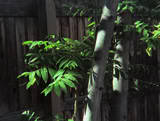
Below are some sample photos from the Contaflex shot in San Francisco in November of 2006:
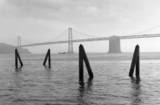
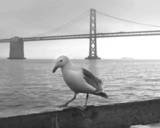


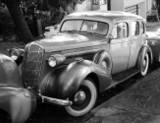
There is a long thread about all the Contaflex models at the Rangefinder Forum which includes useful tips and illustrations about servicing the cameras.
home vintage cameras index
 © mike connealy
© mike connealy